![]()
![]()
![]()
Use LEFT and RIGHT arrow keys to navigate between flashcards;
Use UP and DOWN arrow keys to flip the card;
H to show hint;
A reads text to speech;
38 Cards in this Set
- Front
- Back
|
Which organelles are unique to plant cells?
|
1. chloroplasts
2. tonoplasts (central vacoule membrane) 3. peroxisome |
|
|
What is the nucleus?
|

1. it is a double nuclear membrane that is contiguous with rER. (allows nuclear membrane to be pulled back into ER during mitosis)
2. space between the nuclear membrane's is continous with rER space. |
|
|
function of nuclear pores and where are they located?
|
the nucelar pore dot the surface of the nucleus and they regulate waht moves in and out of the nucleus
|
|
|
What stuff are allowed to be transported out from the nucleus?
|
1. rRNA
2. nRNA 3. tRNA 4. cell signal molecules |
|
|
transcrition:
|
making RNA occurs in the cell nucleus
|
|
|
Translaltion:
|
occurs in the cytoplasm
the genetic code carried by mRNA is decoded to produce the specific sequence of amino acids in a polypeptide chain |
|
|
What stuff are allowed into the nucleus?
|
1. polumerase and other enzymes
2. second messenger molecules |
|
|
What stuff is kept in the nucleus?
|
1. chromosomes
2. histone proteins 3. transcriptions factors, etc. |
|
|
what is the nuclear lamina?
|
a protein scaffold that supports the nuclear membrane (located underneath the membrane)
|
|
|
What system is the nucleus part of?
|
the endomembrane system which is a functional system taht is internal and all connected.
|
|
|
What are the functions of the nucleus?
|
1. valut: retains/ protects chromosomes from reactive chemicals of cytoplasm such as oxidation phosphoralation.
2. site of nuclear transcription and regulation of transcription. 3. site of DNA replication and storage 4. site of mitosis and cytokinesis 5. nuclear transport |
|
|
What is the endoplasmic reticulum?
|
1. a system of membrane channels and sacs
2. is part of the endomembrane system |
|
|
what are the two types of endoplasmic reticulum?
|
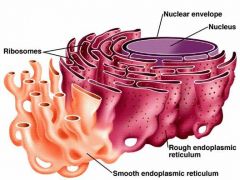
1. rough endoplasmic reticulum (50% of total membrane)
2. Smooth endoplasmic reticulum (which is much of the rest membrane) |
|
|
rough endoplasmic reticulum:
|
1. is directly attached to the nucleus
2. has ribosomes which give it its rough characteristic 3. has a pancake- like morphology |
|
|
What are the functions of the rough endoplasmic reticulum?
|
1. translation of processed mRNA (on the surface)
2. production and modification of proteins (in the lumen) 3. synthesis of lipids (in the lumen) |
|
|
Smooth endoplasmic reticulum?
|
1. is attached to the rER and more peripheral (closer to the membrane)
2. there is no ribosomes 3. more tubular in form |
|
|
Functions of smooth endoplasmic reticulum:
|
1. transport of proteins to Golgi via transport vesicles that bud off sER (on the surface)... bridge from the synthesis to Golgi
2. modification of proteins: add prosthetic groups (mostly metals.. added after proteins are made), carbohydrates, cleaves into smaller peptides, form tertiary structures (in the lumen) 3. provides spaces for reactions that require environments different than that in the cytoplasm (in the lumen) |
|
|
Golgi:
|
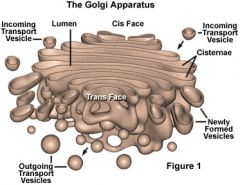
1. stack of membrane bound sacs
2. cis face: receives transport vesicles with proteins for modification and sorting (recieve vesicles from sER) 3. trans face: forms vesicles containing modified proteins for transport to plasma membrane or form lysosomes 4. part of the endomembrane system ** shipping, modifying, distribution center *** |
|
|
Vesicles:
|

1. there are many types
2. they are membrane bound 3. bud from: the ER (transport vesicles), plasma membrane (endosomes), golgi (most others) 4. guided to destination by snare proteins of the vesicle membrane (specific to a certain protein) |
|
|
some type of vesicles:
|
1. lysosome
2. endosome 3. secretory vesciles 4. transport vesciles |
|
|
lysosomes:
|
Golgi derived, sacs of digestive enzymes in cytoplasm, combine with endosomes or aging organeles to destroy and recyle
|
|
|
endosome:
|
invaginated from plasma membrane to bring in by endocytosis (RME), specific compounds or things to be destroyed for food or safety of the cell (bacteria),
|
|
|
can plants carry out phagocytosis or pinocytosis? why?
|
no because of cell wall
|
|
|
secretory vesicles:
|
golgi derived, carry protein hormones, digestive enzymes, or other signal chemistry to be secreted outside the cell by exocytosis
|
|
|
transport vesicles:
|
are within the cytoplasm
|
|
|
Mitochondria:
|
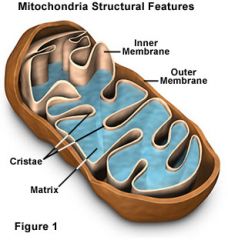
1. consists of double membrane bound sacs
2. many are scattered in the cytoplasm 3. contains its own chromosomes, ribosomes 4. power house of the cell 5. is the site of: - the krebs cycle (matrix) - ETS (inner membrane) which makes chemiosmotic potential (intermembrane space) - ATPase to use to make ATP |
|
|
cytoskeleton:
|
1. at least 3 separate proteins make up scaffolds and have many different functions
- actin - microtubules - intermediate filaments 2. all are very important in cellular functions |
|
|
actin:
|
pushes out plasma membrane allowing ameboid movement, maintains or changes cellular shape
|
|
|
microtubles:
|
flagella, cilia, highways for organelle and vacuolar movement inside cell, chromosome movement in mitosis
|
|
|
intermediate filaments:
|
nuclear lamina, cell shape
|
|
|
which organelles are specific to plant cells?
|
1. chloroplasts
2. tonoplast membrane of central vacuole 3. plant cell wall 4. peroxisome |
|
|
Tonoplast:
|
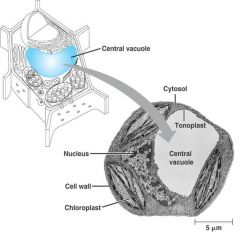
1. the largest organelle in living plant cells
2. pushes most of other organelles to periphery of cell 3. bilayer membrane sac 4. part of endomembrane system |
|
|
Functions of the tonoplast:
|
1. dynamic storage site (water storage site)
2. main storage site for water in cell (necessary since the plant cant move when it rains) 3. plants can use the internal pressure of water (tugor pressure) to put pressure on cell wall during growth (hydrostatic jack) [ helps to make cell larger] 4. storage for dissolved ions (K+, Cl-, Na+, etc) 5. storage site for proteins or metabolic by products that would be destructive in cytoplasm 6. storage site for pigments other than chlorophyll (which is in the chloroplast) |
|
|
Cell Wall:
|
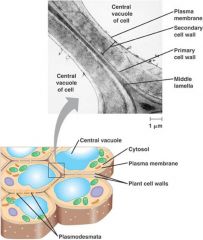
1. are found in all plant cells [ within plants they are momphyletic (one evolutionary development) but compared to everything it is multiphyletic.
2. are thick and complex and made of layers of cellulose fibers [beta-1-4-glucose (very though to break, very strong)], and proteins 3. multiple layers are at angles to each other 4. the middle lamella between them holds the cell together 5. consist of primary cell wall and secondary cell wall which is laid down later in the secondary growth phase. |
|
|
Function of cell wall:
|
1. gives cell shape
2. rigidity 3. physical protection 4. retains cell membrane intact under high hydrostatic pressure ( like a cage retaining the central vacoule from bursting) |
|
|
Peroxisome:
|

1. specialized metabolic compartment
2. found in most cells but functions vary widely 3. variety of oxidizing reactions occur here. (the place to carry out dangerous reactions) |
|
|
function of peroxisome:
|
1. catabolize fatty acids by beta-oxidation to make acetate (Co-A) for energy
2. also can anabolize fatty acids into sugars in fat storing seeds (glyoxysome) 3. has detoxifying functions such as breaking down alcohols in liver, breaking down other toxic compounds in plants. [ usually done by adding electrons and protons to toxic cheicals to make peroxide which is poisonous. peroxide is broken down by perodidase in the perodisome] |
|
|
What is beta-oxidation:
|
is the clipping off of two carbons at a time making acetate (Co-A) and sent off to the kreb cycle.
|

